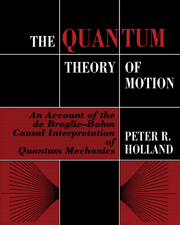 The Quantum Theory of Motion
The Quantum Theory of Motion Book contents
- Frontmatter
- Contents
- Preface
- 1 Quantum mechanics and its interpretation
- 2 Hamilton–Jacobi theory
- 3 Elements of the quantum theory of motion
- 4 Simple applications
- 5 Interference and tunnelling
- 6 The classical limit
- 7 Many-body systems
- 8 Theory of experiments
- 9 Spin ½: the Pauli theory
- 10 Spin ½: the rigid rotator
- 11 The Einstein–Podolsky–Rosen experiment and nonlocality
- 12 Relativistic quantum theory
- References
- Index
4 - Simple applications
Published online by Cambridge University Press: 20 January 2010
- Frontmatter
- Contents
- Preface
- 1 Quantum mechanics and its interpretation
- 2 Hamilton–Jacobi theory
- 3 Elements of the quantum theory of motion
- 4 Simple applications
- 5 Interference and tunnelling
- 6 The classical limit
- 7 Many-body systems
- 8 Theory of experiments
- 9 Spin ½: the Pauli theory
- 10 Spin ½: the rigid rotator
- 11 The Einstein–Podolsky–Rosen experiment and nonlocality
- 12 Relativistic quantum theory
- References
- Index
Summary
Stationary states
General properties
We shall consider first some general characteristics of the ‘stationary states’. These are eigenfunctions of the Hamiltonian operator:
The requirement that ψ satisfies the Schrödinger equation fixes its time dependence:
Notice that (4.1.2) can only be a solution if the external potential V is independent of the time: V = V(x). The initial function ψ0 is not arbitrary but must satisfy the time-independent Schrödinger equation (4.1.1).
Writing ψ = R eiS/ħ one thus has
The following deductions may be made from (4.1.3):
(a) The probability density is independent of the time: |ψ|2 = R20(X).
(b) The quantum potential Q = (- ħ2/2mR0)∇2R0 is time-independent. Therefore so is the total effective potential:
(c) The velocity field v = (l/m)∇S0 is independent of time and hence the trajectories, found by solving m = v(x)|x=x(t), are solutions of
Moreover, ψ0(x) is often a real function for many bound state problems of interest (although not for scattering states) which implies that the velocity is zero. The particle is at rest where one would classically expect it to move since the quantum force (- ∇Q) cancels the classical force (- ∇K).
(d) The energy of all particles in the ensemble, -∂S/∂t, is a constant of the motion and equal to the energy eigenvalue:
with (4.1.4), we have an example of the conservation of energy (cf. §3.9.3).
(e) The total field energy is conserved: 〈Ĥ〉 = E.
[…]
Information
- Type
- Chapter
- Information
- The Quantum Theory of MotionAn Account of the de Broglie-Bohm Causal Interpretation of Quantum Mechanics, pp. 136 - 172Publisher: Cambridge University PressPrint publication year: 1993